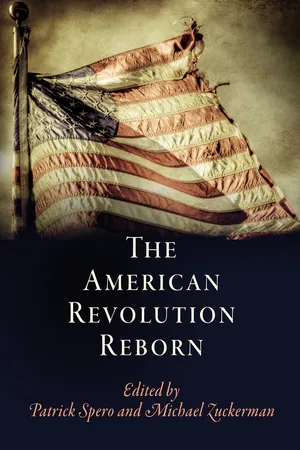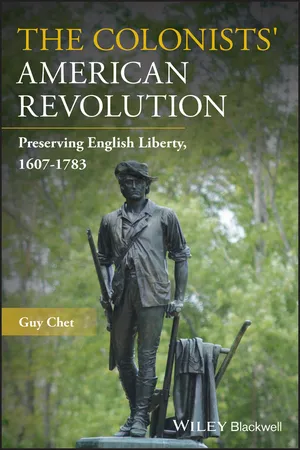History
Battles of the American Revolution
The Battles of the American Revolution were a series of military engagements fought between the American colonies and Great Britain from 1775 to 1783. Key battles included Lexington and Concord, Bunker Hill, Saratoga, and Yorktown. These battles were pivotal in shaping the outcome of the war and ultimately led to the independence of the United States from British rule.
Written by Perlego with AI-assistance
Related key terms
3 Key excerpts on "Battles of the American Revolution"
- eBook - ePub
- Patrick Spero, Michael Zuckerman(Authors)
- 2016(Publication Date)
- University of Pennsylvania Press(Publisher)
PART I Civil Wars: Challenging the Patriotic NarrativePassage contains an image CHAPTER 1 War Stories Remembering and Forgetting the American Revolution MICHAEL A. MCDONNELL
We all love a good story. And the best stories usually pit good against bad, heroes against villains. Such stories become more compelling when they take on larger meaning than the plot itself. When a battle between good guys and bad guys becomes a battle between the forces of liberty and tyranny. When the fate of humankind hangs in the balance. When David takes on Goliath and, against all the odds, triumphs in the face of adversity, in a glorious cause.Such stories are irresistible, especially when they are founding stories. The story of the American war for independence is one such tale. As William Huntting Howell has recently written, “the American Revolution narrates beautifully in the popular imagination.” There is a clear beginning, at Lexington and Concord, and a series of “progressive middles, unfolding against now-hallowed spaces.” Epic battles at Bunker Hill, Trenton, Saratoga, and Cowpens. Trials and tribulations at New York, Valley Forge, Morristown, and Charleston. Clear lines drawn between the patriots and the monarchical forces of the British and their loyalist minions. And the stakes are high and obvious: independence or dependence; democracy or monarchy; liberty or tyranny. The choices are simple and the denouement is almost inevitable: victory at Yorktown and the creation of a new nation.1Historians are equally wedded to this tale. We frame our books and the courses that we teach around the story. We follow the same plot from resistance to independence, from Lexington to Yorktown, and from the Continental Congress to the federal constitution. To be sure, we tell the story in different ways and with different emphases. Some of us focus on patriot leaders, others highlight the role of popular action. We differ over the motives of patriots and the relative importance of particular groups and people. We disagree over whether rights and liberties were fought for or ought to have been extended to different communities within that new nation. We puzzle over the seeming contradictions inherent in a war fought for liberty that also entrenched slavery and legitimated the conquest of Native Americans. Sometimes we pause and consider those who opposed the unfolding story. But rarely do we question the story itself.2 - eBook - ePub
- Jerome R Reich(Author)
- 2016(Publication Date)
- Routledge(Publisher)
Bonhomme Richard . Even more important was his seizure of numerous English merchant ships in their home waters. Before the war came to an end, over 2,000 English ships were captured by the Continental navy and American privateers.England greatly underestimated France’s desire and capacity for revenge, which stemmed from the latter’s defeat in the Seven Years’ War; it also miscalculated the enmity against England which had developed in numerous European nations because of the wars fought since 1689. The help in money and naval support which the United States was to receive—particularly from France, Spain, and Holland—proved crucial to the outcome of the war. Finally, due credit must be given to George Washington, whose character and example—even more than his military skills—were major factors in winning American independence. Washington did not win many battles, but he saw to it that an American army always remained in the field, thus making ultimate English victory impossible.Washington among his troops. Source: © Corbis.The Campaigns of 1776-1777
The military history of the American Revolution may be dealt with relatively briefly. In March 1776 the English army—now commanded by General William Howe—evacuated Boston, leaving the New England states in safety (except for sporadic raids) for the remainder of the war. Earlier, American troops under the command of Generals Richard Montgomery and Benedict Arnold had made a gallant but unsuccessful effort to conquer Canada. Although Montgomery captured Montreal, weather, smallpox, and the English army saved Quebec. No other military operations were undertaken against Canada, although members of the Continental Congress continued to hope that Canada would voluntarily join the United States. - eBook - ePub
The Colonists' American Revolution
Preserving English Liberty, 1607-1783
- Guy Chet(Author)
- 2019(Publication Date)
- Wiley-Blackwell(Publisher)
By the same token, the Americans' overwhelming advantage in manpower reserves explains why they chose to fight a conventional war against Britain, rather than adopt guerrilla tactics, which are widely understood as the weapon of the weak. The war thus started and ended as a conventional eighteenth‐century war of attrition, which favored the side with greater manpower resources. The British lost this contest because of logistical, financial, and political exhaustion, rather than by losing major battles.Early Engagements
Following the battles of Lexington and Concord, many Patriots had great faith that colonial militia could stand up to British regulars as they had done on the Lexington road. Following the English tradition, Patriot pamphleteers, editorialists, and recruiters called on Americans to organize and dedicate themselves for military service, since a militia of free men was the natural weapon and true protector of a free society. The Massachusetts provisional government asked many of the militiamen that rose up in rebellion on April 19 to stay armed and ready. By the end of April, a rebel camp of over 10 000 men from Massachusetts, Connecticut, and New Hampshire encamped outside Boston, holding General Thomas Gage and his army captive in the city. The commander of the New England army, Artemas Ward, did not insist on military formalities and camp protocols. Discipline was lax, with citizen‐soldiers coming and going from camp at will, and taking orders casually, if at all.Many Patriots, and especially the troops themselves, did not find this disorderly conduct troubling. Indeed, they reveled in the contrast between themselves and British regulars, stressing that the joyous freedom that Patriot troops were living in their camps was emblematic of the liberty they were fighting to preserve in their civic lives. Moreover, they held that even militarily, liberty was more energetic than disciplined force. The successful Patriot attack on Fort Ticonderoga (May 10, 1775) – an attempt to capture artillery pieces for the New England army besieging Boston – reinforced this belief. Undermanned and caught by surprise, the fort's defenders offered no resistance whatsoever.This optimism faded quickly after the Battle of Bunker Hill (June 17, 1775), one of the bloodiest battles of the entire war. By launching frontal assaults on the fortified Patriot positions, rather than flanking them, the British lost 1054 men (40% of the force). The Patriots lost 411 men (30% of their force). Both sides were stung by the fierce action that day, recognizing the need for a better approach in future engagements.
Learn about this page
Index pages curate the most relevant extracts from our library of academic textbooks. They’ve been created using an in-house natural language model (NLM), each adding context and meaning to key research topics.


